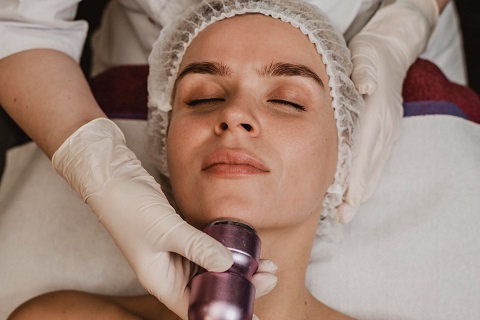Skin pigmentation issues are a common concern for many individuals, affecting not only aesthetics but also self-esteem. Understanding the science behind anti-pigmentation treatments is crucial for making informed decisions about the most effective solutions.
In this comprehensive exploration, we delve into pigmentation mechanisms, diverse pigmentation disorders, and the science behind successful anti-pigmentation treatments. For personalized professional consultation, visit MOYEM, your trusted skin care partner.
Understanding Skin Pigmentation
The Role of Melanin
Melanin, a complex polymer derived from the amino acid tyrosine, is integral to the coloration of skin, hair, and eyes. Synthesized by melanocytes within the epidermis, melanin exists in two primary forms: eumelanin, imparting brown and black hues, and pheomelanin, responsible for red and yellow tones.
The intricate interplay of these pigments determines the diverse spectrum of human skin tones, highlighting the fascinating biological processes governing our outward appearance.
Types of Pigmentation Disorders
Hyperpigmentation occurs when melanocytes produce an excessive amount of melanin, leading to darkened areas on the skin. This can result from sun exposure, hormonal changes, or inflammation.
Conversely, hypopigmentation arises when melanin production decreases, causing lightened skin patches. Melasma, characterized by brown or grayish patches, often arises during pregnancy, while sunspots are a consequence of UV exposure.
Post-inflammatory hyperpigmentation follows skin trauma or inflammation, leaving dark marks. Understanding these variations is pivotal for tailoring effective anti-pigmentation treatments.
The Science Behind Anti-Pigmentation Treatments
Targeting Melanin Production
In the quest to treat pigmentation issues effectively, addressing the root cause, namely melanin overproduction, is paramount. Targeting melanin synthesis, numerous treatments utilize topical agents containing tyrosinase inhibitors, essential enzymes in melanin formation.
Renowned for their efficacy, ingredients like hydroquinone, kojic acid, and arbutin disrupt this process, contributing to the gradual lightening of dark spots.
These compounds work synergistically to regulate pigmentation, providing a multifaceted approach to achieving a more balanced and uniform skin tone.
Hydroquinone: The Gold Standard
While Hydroquinone’s efficacy in inhibiting melanin production makes it a go-to choice for many in anti-pigmentation treatments, concerns over potential side effects have sparked a search for alternatives.
Skin irritation and the risk of ochronosis, a condition causing bluish-black discoloration, are key drawbacks associated with Hydroquinone. This controversy has prompted researchers to delve into natural alternatives and innovative compounds that offer comparable benefits without the adverse effects.
The quest for safer yet potent solutions reflects the ongoing evolution of anti-pigmentation treatments, as the skincare industry strives to balance effectiveness with patient safety and well-being.
Natural Alternatives: Exploring Botanical Extracts
In response to concerns about synthetic compounds, there has been a growing interest in natural alternatives derived from botanical extracts.
Plant-based ingredients like licorice extract, niacinamide, and vitamin C have demonstrated promising results in inhibiting melanin synthesis. These alternatives not only offer effective pigmentation control but also bring antioxidant and anti-inflammatory benefits to the skin.
Exfoliation and Cell Turnover
Another key aspect of anti-pigmentation treatments involves promoting exfoliation and increasing cell turnover.
Chemical exfoliants, such as alpha hydroxy acids (AHAs) and beta hydroxy acids (BHAs), play a crucial role in removing the outer layer of dead skin cells. This not only helps to fade existing pigmentation but also stimulates the growth of new, evenly pigmented skin.
Retinoids: Accelerating Cell Renewal
Retinoids, derivatives of vitamin A, are powerful compounds known for their ability to accelerate cell renewal.
By promoting the shedding of old skin cells and encouraging the production of new ones, retinoids contribute to a more even skin tone. However, it is essential to use retinoids cautiously, as they can cause skin sensitivity and irritation.
Laser and Light Therapies
For more severe pigmentation issues or cases resistant to topical treatments, laser and light therapies offer advanced solutions.
Intense Pulsed Light (IPL) and laser treatments target melanin in the skin, breaking down dark pigmentation and promoting the regeneration of clearer, more evenly toned skin. These therapies are often used for conditions like melasma and stubborn sunspots.
Fractional Laser Therapy
Fractional laser therapy is a precise approach that targets specific areas of pigmentation, creating microscopic injuries to stimulate collagen production and expedite the healing process.
This results in a reduction of pigmentation and improved skin texture. Fractional laser therapy is particularly effective for treating age-related pigmentation issues and acne scars.
Conclusion
In the pursuit of clear and even-toned skin, understanding the science behind anti-pigmentation treatments is essential. From inhibiting melanin production with tyrosinase inhibitors to promoting exfoliation and cell turnover, various approaches address pigmentation disorders at different levels.
While hydroquinone remains a gold standard, natural alternatives and advanced laser therapies offer diverse options for individuals seeking effective solutions.
In making decisions about anti-pigmentation treatments, it is crucial to consider individual skin types, potential side effects, and the severity of pigmentation issues.
Consulting with dermatologists or skincare professionals can provide personalized guidance, ensuring that the chosen treatment aligns with both scientific principles and individual needs.
Ultimately, by combining scientific knowledge with innovative treatments, individuals can embark on a journey toward achieving the clear and radiant skin they desire.
